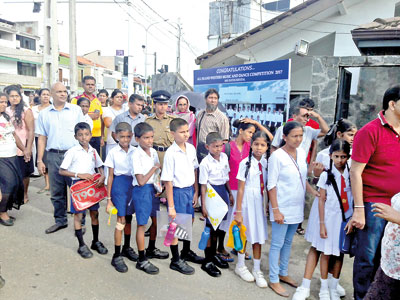News
Year-Five Scholarship exam: Some random reflections on our education system
View(s):One of the visible features of our current education landscape is its high pressure environment. While there is a welcome recognition of parents across the board that their children’s future will be determined largely by their educational and professional attainments, the pressure on the young one’s is largely influenced by the failure of the system to provide the space and guidance for children to acquire knowledge at a pace commensurate with their age and in an enjoyable manner.
There has been considerable discussion about the mismatch in our education system producing graduates not equipped to meet the requirements of a highly technological and commerce driven economy. There have been several initiatives being discussed and some implemented to address what is viewed as a lacuna in our system of education.
As a result the system is on overdrive and children are compelled to absorb knowledge which they can easily do at a later stage. For example in pre-school, the child is supposed to be gently eased into an informal setting by preparing for his or her future by learning through fun and play. Yet, in today’s context, the child is taught and expected to learn the alphabet and numbers which process is expected to be completed before the child enters formal schooling in Grade One at the age of five.
In the past before the rat race in education, they began learning these only when they entered the stage of formal schooling. Today several topics their grandparents learnt in upper primary classes and middle school are introduced to the young ones in lower classes. The grandparents who followed the earlier leisurely paced system have not done too badly in life and many are excelling in their chosen fields in various parts of the world.
Today’s youngsters have to carry heavy bags of books to school and this is symbolic of the information overload that is characteristic of today’s school life. Many grandparents of today remember their school days as days of fun and play and cannot remember ‘cramming’ for the Year 5 exam or even the Ordinary Level.
In some advanced and progressive educational systems, rote learning methods have given way to the learning to learn methodology where students are encouraged to achieve educational goals through their own efforts under the guidance of their mentors.
In Japan the competition to achieve educational goals have often pushed the students to the brink of suicide when they fail to realise the targets they set for themselves. We in Sri Lanka should take urgent steps to spare our future generations from such pressures by re-orienting our education system to more student friendly systems.

Students waiting to enter an exam centre in Matara for the scholarhip exam held in August. Pic by Krishan Jeewaka Jayaruk
One of the biggest manifestations of this high pressure educational environment is the annual Year 5 examination. The main objective of this examination is to enable the high achievers to enter the top public schools to pursue their studies at the secondary level. A lesser objective is the awarding of stipends to facilitate those who become entitled to them based on the exam results.
Many researchers and educationists have written on the impact of this exam on the students and the school system. The general consensus is that the pressure generated by the competition among the more than 300,000 students who annually sit this examination is too much for the young minds and is also not critical to their progress.
What adds to pressure is the hype by media and commercial institutions who attempt to glorify the achievements of the successful ones by giving them special monetary and other awards. It thus becomes a mark of social achievement.
There does not seem to be much research done to track the progress of the Year Five Scholarship achievers to see whether they live up to their potential in the future exams such as the Ordinary Level and Advanced Level examinations or whether they burn themselves out early and consequently whether there is a fall in their performance as they climb the educational ladder.
Another fact to be considered is how much of a culture shock it is for the eleven year olds when they move into the big school environment. It must surely be difficult for them when they have to move into hostels away from the comfort of their homes and to interact with peers who have been born and bred in the big cities. Given the resilience of young ones they do survive but the question is, is the price worth paying.
It is not only the village-city dimension that comes into play in the change of school. Several years ago, a student from a small school in Kollupitiya (close to Temple Trees) won the Year Five Scholarship and entered Royal College. He struggled for some time to adjust to his new school environment but ultimately gave up and returned to his former school. We do not know how many young ones suffer silently through secondary school either to please their parents or not to suffer the social stigma of having to return to their previous School.
Another adverse effect of the Year 5 Scholarship examination is the detrimental effect it has on the development of schools. The big schools benefit by the entry of the scholarship holders and some argue that a large percentage of the good results achieved by these big schools are from among the Year 5 scholars who entered the school.
The lesser known schools which produce these scholars can never hope to improve their image as they lose the cream of their students to the bigger schools and are, therefore, condemned to remain where they are in the ranking of schools. Successive governments have promised to establish a Royal College in every district or electorate, but this goal has yet to be realised. If this admirable target is realised the pressure to gain admission to the bigger schools at Year One or on the basis of the Year Five Scholarship examination will ease and the ‘Langama Pasala’ (the nearest school) will indeed become the ‘Hondama Pasala’ (the best school).
All these issues crop up mainly due to the disparities in education among the different districts and schools. It is only if this gap is bridged effectively that the whole issue of clamouring to get into popular schools can be resolved. While different governments have come up with various initiatives, the problem does not seem to go away as seen by the desperate scramble for places in the big schools everywhere.
One of the areas that seemed to be missed out is the failure to improve the quality of classroom teaching. The overemphasis on infrastructure development without correspondingly improving the teaching standards is another factor that has prevented the lesser known schools from progressing.
In this area there is an untapped resource available for the Ministry of Education. There are many former principals and other educationists with decades of experience who can provide ready and speedy advice to address this among other issues. Their accumulated wisdom should be put to beneficial use without it being lost to the country.
(javidyusuf@gmail.com)

